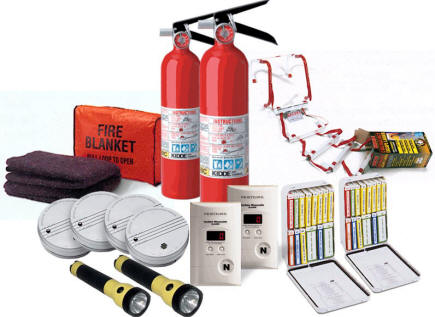Planning is the key to protecting your home and your family during a natural disaster. While there’s little we can do when our homes stand in the path of Mother Nature, you can take precautions to minimize any potential damage to your home and ensure an escape plan. Here we’ll look at the main types of disasters that homeowners face and how you can prepare for each event.

Fire Hazards
Fire safety should be a top priority for all homeowners. Whether a kitchen fire gets out of hand or you live in an area that is prone to wildfires, the destruction caused by a fire can be devastating. With the help of a handyman, there are several steps that you can take to prevent and respond to a fire threat.
Does your home have a working fire alarm and fire extinguisher? As a homeowner, should make sure to periodically test your fire alarms. Your fire extinguisher should be installed in an accessible location close to where the threat of a fire is greatest.
If you live in an area that is prone to wildfires, it is recommended that you create a safety zone around your home that is between 30 and 100 feet. Within this zone, clear all flammable materials, such as shrubs, leaves, vines, and dead branches. Regular upkeep of this zone can help to slow the spread of a fire on your property.
In anticipation of a fire emergency, it is important to plan an escape route. Installing escape ladders in a multi-story home allows your family to quickly evacuate. An inspector can give you some guidance in planning the best routes of escape during a fire.
Tornados and Hurricanes
Hurricanes and tornados are marked by high velocity winds that have the potential to damage your property. Flying debris is the biggest hazard caused by storms and often contributes to bodily injury or death.
The first line of defense against flying debris is to install hurricane shutters which will protect your windows from being broken.
After your windows, the roof of your home is the next biggest vulnerability during a storm. Changes in air pressure can cause your roof to cave in. By installing hurricane straps and bracing, you can provide extra support to prevent your roof from collapsing.
Floods
Homeowners who live near large bodies of water or experience excessive rainfall are especially at risk of flooding. The presence of electronic items is the biggest hazard that homeowners face in the event of a storm. As a safety precaution, homeowners in flood-prone areas should elevate their furnace, water heater, and electric panel to guard them against basement flooding.
Homeowners can also protect the lower level of their home by sealing their basement walls with special waterproofing compounds. By removing porous materials from your home, like wood, you can guard your home against water damage. A handyman can assist you in identifying materials for your home that are most resistant to water.
These are just a few of the precautions that homeowners can take to protect their property and families during a disaster. However, the level of preparation you need will greatly depend on where you live. A professional can help you make the right home improvements to meet your safety needs.
Bryan Grayson writes about home improvement and disaster relief.

